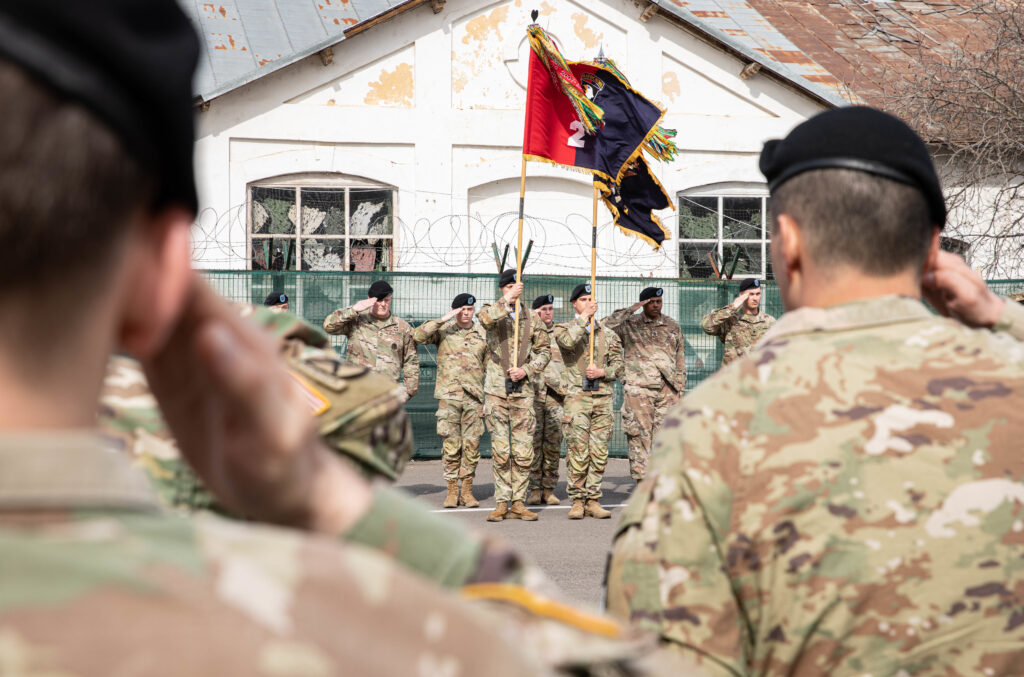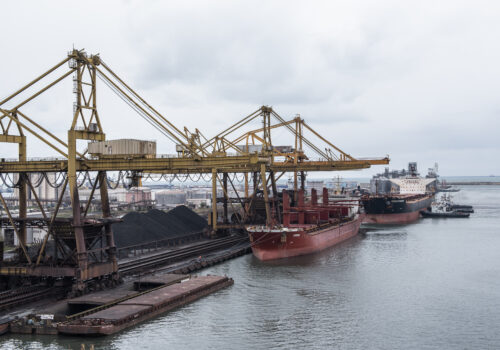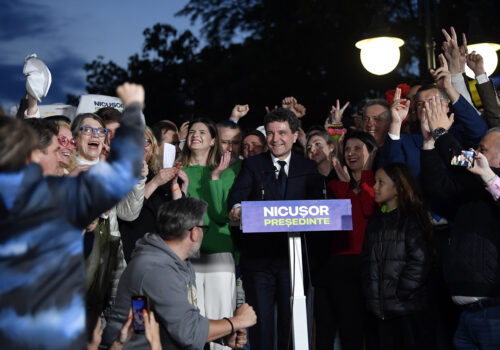On Wednesday, the Romanian defense ministry and US military announced that the United States will withdraw a brigade of troops that had been rotating throughout the region, including being stationed at a Romanian air base. It was the first officially announced step in the Trump administration’s planned pullback of its European force presence. To learn more about the redeployment and its broader significance, we reached out to our experts in Bucharest and Washington.
Click to jump to an expert analysis:
Alex Serban: A transition from reassurance to co-ownership of defense
Philippe Dickinson: This is far from the worst outcome for Europe
A transition from reassurance to co-ownership of defense
BUCHAREST—The big question across NATO’s eastern flank today is: Should this development be understood as a retreat by the United States or a strategic reconfiguration?
Romanian authorities confirmed that approximately one thousand US troops will remain stationed in the country. Key allied strategic assets will remain untouched, such as the Deveselu missile-defense site and the Mihail Kogălniceanu (MK) Air Base, which is undergoing a two-billion-dollar expansion to become one of NATO’s largest and most capable bases in Europe. Reuters reported that a NATO official also underscored on Wednesday that the overall US military presence in Europe “remains larger than it has been in many years,” framing the decision as part of a regular adjustment in posture rather than a withdrawal.
Indeed, Romanian President Nicușor Dan had already informed Parliament in August about approving the pre-positioning of military equipment and new US contingents at MK Air Base, describing it as “a strategic reconfiguration, not a withdrawal,” in the context of rising instability in the Middle East and NATO’s ongoing consolidation.
But Washington’s decision may bring unintended consequences. This regional brigade was a reminder that in the face of populist politics and Russian interference—via drones, sabotage, and disinformation—weakened democracies such as Bulgaria, Slovakia, and Hungary still had a Western commitment and troops to rely on. Instead of reflecting confidence that allies like Romania can host, integrate, and operate advanced assets within a broader NATO command structure, populist politicians and extremist voices may use this pullback as a signal that Moscow is once again setting the region’s clock.
For Bucharest, it is a call to maintain momentum in modernizing its armed forces, investing in logistics and surveillance systems, and aligning its defense planning with both NATO and the European Union’s (EU’s) emerging defense initiatives, including within the Bucharest Nine format of NATO’s eastern flank countries.
From Moscow’s perspective, the move will be applauded and seen as a weakening of US resolve. In reality, however, if the United States and Europe make strong commitments, a more agile and networked posture—anchored in Romania—strengthens deterrence by enhancing mobility, intelligence, and rapid reaction capacity across the Black Sea.
Ultimately, this decision could mark a transition from reassurance to co-ownership of defense. The transatlantic partnership is not retracting; it is evolving and transforming, requiring Europe, and Romania in particular, to turn political reliability into operational capability. Romania is looking to its US ally to send clear messages and commit firmly to continue its presence across the region as a deterrent to Russian aggression.
That’s why Pentagon and NATO leaders should go the extra mile and further underscore that no future retrenchment will take place in the next three years. US military investments in Romania should remain steadfast and continue to expand, particularly at MK Air Base.
Meanwhile, Europe should step in and backfill for the departing brigade. Romania and the EU must deepen their own defense investment, financially, industrially, and in troop commitments, to ensure that NATO’s forward presence is matched by credible European capabilities.
—Alex Serban is the senior advisor for the Atlantic Council’s Romania Office and a nonresident senior fellow in the Transatlantic Security Initiative at the Atlantic Council’s Scowcroft Center for Strategy and Security.
This is far from the worst outcome for Europe
WASHINGTON—This is a day that many in Europe have feared for some time. But it shouldn’t come as a surprise—this is a clearly stated policy direction that the Trump administration has communicated for several months.
It also shouldn’t be a time to panic. The administration has been trying to reassure European allies that the planned reconfiguration of the US presence on the ground in Europe will be gradual and moderate, returning US troop numbers over time to levels similar to those before Russia’s 2022 invasion of Ukraine. This move in Romania is broadly in line with that direction. In the range of potential force posture moves the administration could take, this is far from the worst outcome for Europe. The suggestion today from the Estonian defense minister that US troops will remain in the Baltic nation should provide more reassurance.
The administration has generally been pleasantly surprised by the broader European response to the Trump administration’s demands that Europe take on greater responsibility for its own security, with the NATO 5 percent spending target being the standout success. Europe’s cooperation should strengthen the hand of those within the administration arguing for a phased and moderate reorientation done in coordination with NATO and European allies.
The lesson for European leaders should be that showing progress on their own defense spending and capabilities is the best way to keep the Americans on board and engaged in the project of European security. And it helps them frame as more reasonable their critical asks of Washington: US enablers that are not easily replaced (intelligence, surveillance, and reconnaissance; long-range strike capabilities; command and control; logistics and transport; and the US nuclear umbrella) and the maintenance of a thin but broad US physical presence along the eastern flank that can be scaled at speed in a crisis.
With that said, Moscow will inevitably interpret this move as a message that, while the United States is most certainly not abandoning Europe, it is serious about its efforts to reconfigure its European force posture. To neutralize any potential emboldening of Moscow, the United States should find other ways to signal clear, long-term resolve to deter further Russian aggression. The recent sanctions package is an excellent start. Providing Ukraine with Tomahawk missiles and committing critical enablers to Ukraine after a cease-fire would be even better.
—Philippe Dickinson is a deputy director with the Transatlantic Security Initiative. Prior to joining the Council, he was a career diplomat with the United Kingdom’s Foreign, Commonwealth and Development Office.
Further reading
Wed, Aug 6, 2025
Energy is key to Romania’s trade resilience
EnergySource By Uliana Certan
While the new US-EU trade agreement may pose economic risks for Romania, it also presents a strategic opportunity to stabilize its economy by leveraging its unique energy profile.
Mon, May 19, 2025
Experts react: What message did Romanians send by electing Nicusor Dan?
New Atlanticist By
The mathematician and mayor of Bucharest came out ahead of his right-wing rival on May 18. Atlantic Council experts sum up the election results and the implications.
Sun, May 18, 2025
Why Romania chose centrism in the end
Fast Thinking By
Following Bucharest Mayor Nicusor Dan's election win, our experts give their takes on what to expect next for Romania and for the country's relations with the world.
Image: Soldiers assigned to the 2nd Brigade Combat Team, 101st Airborne Division (Air Assault) and the Romanian 2nd Infantry Division held a joint award ceremony on March 8, 2023, in Buzau, Romania. (US Army photo by Staff Sgt. Malcolm Cohens-Ashley, 2nd Brigade Combat Team Public Affairs.)




